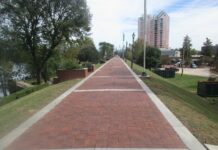Photo credit: DiasporaEngager (www.DiasporaEngager.com).
By Anthony Smooth, AAIHS —
In 2015, Harvard economists Raj Chetty and Nathaniel Hendren did a study on how the socioeconomic conditions of the neighborhoods in urban cities like Los Angeles, St. Louis, Cleveland and Newark can potentially predict a child’s ability to rise out of poverty and achieve upward social mobility. Chetty and Hendren used “quasi experimental evidence” to study over five million families through an analysis of U.S. tax records from 1996 to 2012, investigate the sociological factors that influence someone’s upbringing in particular communities, and rank one hundred American cities as a prediction of which metropolises offered its youth the greatest potential for economic mobility. According to Chetty and Hendren, the City of Baltimore ranked at 100, since every year of exposure to the city’s socioeconomic environment “reduces a child’s earnings by 0.7% per year” and individuals aged 20 or older who “grew up there from birth” see their “total earnings” reduced by approximately 14% in comparison to the national average. Baltimore currently has a poverty rate of 20.3%, which is 58.59% higher than the national average. Like many other American cities, Baltimore is a post-industrial city in the Rust Belt with an impoverished population that is largely African American whose economic problems can in part be attributed to deindustrialization. The Great Migration of African Americans from the South to Northern urban centers during the first half of the twentieth century coincided with the rusting of what was once known as the Steel Belt. Like Philadelphia, Trenton, Detroit, Chicago, Pittsburgh, and St. Louis, deindustrialization caused the removal of thousands of jobs in factories like General Motors and Bethlehem Steel that employed Baltimore’s sizable African American population during the early twentieth century. Additionally, twentieth century racial discrimination in housing and education also helped to stifle African Americans’ efforts to achieve upward economic mobility in a postwar era of job flight, white flight, and the decline of municipal budgets. However, in a city that is approximately 62% Black, the racially-distinct, economic disparities we see in Baltimore today began as early as the eighteenth century and are a result of the city’s unwavering commitment to exploited labor. Moreover, the institution of slavery reinforced ideals of white supremacy and condoned the exploitation and neglect of African Americans that helped to economically and culturally shape Baltimore and its social inequality in ways that are still observable today.
During the formative years of the newly formed republic, American cities were a destination for those seeking social and economic advancement in the “land of opportunity” and Baltimore was no exception. The taxonomy of Baltimore as either a Northern or Southern city has often been debated amongst scholars. The urban landscape and commercial value of its port likens it to other Northern cities, but its location relative to the Mason-Dixon Line positions it in the South. The most definitive reason why Baltimore is a Southern city is because it was the largest city in Maryland, a former slave-holding state during the antebellum era. From 1729 onward, Baltimore attracted European immigrants, wealthy and poor whites, along with enslaved and free African Americans. As a slave society, many of Baltimore’s elites owned slaves. In fact, during the nineteenth century, Baltimore’s total African American population rivaled New Orleans, its free Black population was comparable to Philadelphia, and the city’s enslaved population was proportionate to the nearest southern city of Richmond. In the first half of the nineteenth century, Baltimore’s free African American population exceeded its enslaved African American population. Although scholars cannot accurately determine the exact number of undocumented enslaved people who inhabited the city, the constant influx of European immigrants of Irish, Italian, and Jewish descent ensured that Baltimore remained a predominantly white city as it rose to be one of the most populous in the country.
Unlike many Rust Belt cities, Baltimore’s African American population grew exponentially prior to emancipation, industrialization, and the Great Migration. The practice of term slavery and manumissions in Maryland contributed to the state’s large population of free African Americans. Term slavery allowed an enslaved person to serve for a period of time in which they could purchase their freedom at the end of the term. Many Marylanders used the practice of term slavery and manumissions to preserve an institution that became less profitable in the state’s rural regions due to the transition from labor intensive tobacco to the less laborious flour industry as the state’s most valuable crop. According to historian Seth Rockman, Baltimore was a nineteenth century boom town with a diverse labor pool in which employers readily exploited enslaved and free wage laborers to achieve the highest profits possible. Racial inferiority was not only used to validate the enslavement of African Americans, but also to reduce Black labor to the least desirable and most painstaking menial work such as scraping the streets of manure from horse drawn vehicles transporting people and goods throughout the city or dredging the city’s Inner Harbor on the infamous mud machine. Baltimore’s power structure relied so heavily on the exploited labor of free and enslaved African Americans that the city’s enslaved population grew from the city’s founding until 1820, and remained constant for the next decade. The city’s employers were always able to control the price of labor and Baltimore’s “boomtown economy” was dependent on the exploitation of multiple inequalities that intersected along race, class, and gender lines, but overall disproportionately affected African Americans, both enslaved and free.
During the Civil War, Maryland did not secede from the Union, however many Marylanders were sympathetic to the Confederate cause. Among the 85,000 Marylanders who fought in the Civil War, approximately 25,000 were Confederate soldiers. In fact, some Baltimoreans felt so passionate about preserving the institution of slavery that one of the first instances of bloodshed over the issue of slavery occurred on April 19, 1861 during the “Pratt Street Riot” in which Confederate sympathizers attacked Union soldiers from the 6th Massachusetts Militia and the Washington Brigade of Philadelphia who were on their way to Washington, D.C. After the Civil War, Baltimore’s population continued to grow, but its population never again ranked among the top three most populous cities in the country as it once did during the early nineteenth century. According to the U.S. Federal Census, from 1880 to 1980, Baltimore ranked among the top ten most populous cities in the country when its population, despite many ebbs and flows over the decades, rose from 332,313 to 786,741. Additionally, Baltimore’s Black population increased from 16.2% to 54.8% in the span of a century. Although the city gradually became more racially diverse over time, it remained culturally exclusive in its historical narrative. From as early as 1887, city officials chose to adorn Baltimore’s physical landscape with four monuments honoring the Confederacy, including a statue of Judge Roger Brooke Taney, in a covert effort to celebrate those who sought to protect the institution of slavery. A native Marylander, Taney was infamous for his Supreme Court opinion in the 1857 Dred Scott v. Sandford case in which he declared that enslaved people were not American citizens and could not declare their freedom from slavery if they ever reached the soil of a free state. Taney’s statue was unveiled in Baltimore approximately a decade after the Dred Scott Decision was reversed with the passage of the 14th Amendment which gave formerly-enslaved African Americans citizenship and equal protection of civil rights under the law. By 1948, three more Confederate monuments were erected in Baltimore during the Great Migration: the Confederate Soldiers and Sailors Monument; the Confederate Women of Maryland; and the Stonewall Jackson and Robert E. Lee Monument. Monuments remind future generations of a city’s history and legacy. Baltimore’s Confederate monuments were physical representations of how slavery was central to the city’s cultural identity.
In April 2015—the same Spring Chetty and Hendren published their study—Baltimore experienced weeks of protest and riots in reaction to the death of 25-year-old Freddie Gray who was falsely arrested near West Baltimore’s Gilmor Homes housing project for his legal possession of a knife, abused, and suffered fatal spinal cord injuries from the “rough ride” he experienced while in police custody. The Freddie Gray protests were the culmination of mounting frustrations African Americans had about the racially-distinct, socioeconomic conditions in the city that largely disadvantaged people of color. A nationwide response to the racially-motivated mass shooting at Emanuel African Methodist Church in Charleston, South Carolina in June 2015 led to the removal of Confederate monuments across the country, including the four in Baltimore by 2017. For decades, Baltimore’s Confederate monuments stood undisturbed until events like the death of Freddie Gray and other racially-charged incidents throughout the nation forced the city to come to terms with its history of enslavement. Nevertheless, the events of Spring 2015, coupled with the results of Chetty and Hendren’s study, underscore how Baltimore’s past informs its present. The effects of Baltimore’s history as a slave society are a racialized, socioeconomic hierarchy in its modernity.
Anthony Smooth is a MA student in History at Morgan State University. He received his Bachelor’s degree in History from Morgan State. For more than 15 years, he has worked as an educator in the Baltimore City Public School System, a coach and swim instructor for Baltimore City Recreation and Parks Aquatics Division, and a Youth Worker at Roca, Inc. His goal as an academic and activist is to combine his passion for art and history to uplift, enrich, and advocate for citizens of underserved communities. Smooth was born, raised, and lives in the City of Baltimore.
Source: AAIHS
Featured image: A protest in Baltimore following the death of Freddie Gray in police custody (Andrew Stefan/Shutterstock)
Source of original article: The Institute of the Black World 21st Century (ibw21.org).
The content of this article does not necessarily reflect the views or opinion of Global Diaspora News (www.GlobalDiasporaNews.com).
To submit your press release: (https://www.GlobalDiasporaNews.com/pr).
To advertise on Global Diaspora News: (www.GlobalDiasporaNews.com/ads).
Sign up to Global Diaspora News newsletter (https://www.GlobalDiasporaNews.com/newsletter/) to start receiving updates and opportunities directly in your email inbox for free.
































